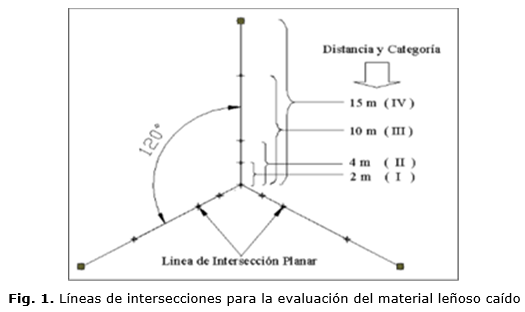Actions for the prevention of forest fires in five stands of Lot 7 belonging to the Guisa Silvicultural Base Business Unit
Main Article Content
Abstract
The work was carried out in the Lot 7 belonging to the Management area “Los Números”, with the objective of elaborating actions for the prevention of forest fires. The method of Intersections Plane was used to measure the combustible material in 28 points of sampling of five plots of Pinusmaestrensis, the climate, the topography and the combustible material were evaluated, the carbon stored in the woody material was also calculated, the index of fire danger was determined and actions were designed for the prevention of forest fires keeping in mind the results generated in the previous analyses. The inclination of the land suggests that the height of the flames and the number of dead trees will be considerable and the biggest affectations will happen in the plot 3. The woody material determines the combustible load in the plots as occupying 69% of the total that means bigger effort to diminish this fraction, in a particular way in the plot 1. This fraction conserves 150 t/ha of carbon that could be liberated to the atmosphere during a fire. Plots 2 - 4 show a low danger and plot 1 a discharge; therefore, it will be necessary to place special attention in plot 1, from the point of view of the execution of works related with the decrease of the danger of the forest, as the assignment and distribution of means against fires. The preventive actions reside in the assembly of informative barriers, the construction of fire walls and the application of prescribed burning.
Downloads
Article Details
References
ACOSTA, R. Y PARETAS, J. J. Incendios forestales. La Habana. Ed: Científico- Técnica, 2011.
ALVARADO, E. Consideraciones sobre los incendios en bosques tropicales y templados de áreas protegidas en México y Brasil. En: Flores G., J. G.; Rodríguez T., D. A.; Estrada M., O.; Sánchez S., F. Incendios forestales. Definiendo el problema, ecología y manejo, participación social, fortalecimiento de capacidades, educación y divulgación. Mundi Prensa-CONAFOR. México, D. F. 2006. pp. 172-184.
ÁLVAREZ B, A. Y MERCADET P, A. El Sector Forestal Cubano y el cambio climático. La Habana, Cuba: Inst. Investig. Agro-Forestales, Ministerio de la Agricultura, 2012.
ÁLVAREZ, P. Y VARONA, J. C. Silvicultura. Editorial Pueblo y Educación, 1988.
BROWN, A.A. Y DAVIS, K.P. Forest fire: control and use. New York: McGraw-Hill, 1973.
BROWN, J. K. 1972. Field of a Rate of Fire Spread modelin Slash Fuels. Intermountain Forestand Range Experiment Station. U.S.D.A. Forest Service, Research Paper INT-116, 1973.
BROWN, J. K. Handbook for inventoring downed woody material. USDA Forest Service. Utah, USA: General Technical Report INT-16, 1974.
CONAF. Manual con Medidas para la Prevención de Incendios Forestales - Región de Magallanes y Antártica Chilena. Santiago de Chile. Ed: CONAF, 2007.
DÍAZ, S. X. Y MOLANO, M. A. Cuantificación y Valoración Económica de la Captura de CO2 por Plantaciones del genero Eucalyptus Establecidas por el Preca en las Cuencas Carboníferas de César, Valle del Cauca-Cauca y altiplano Cundiboyacense. IUFRO-RIFALC: Taller Internacional sobre Secuestro de Carbono, 16-20 julio. Universidad de Los Andes. Mérida, Venezuela, 2001.
FAO. Evaluación de los recursos forestales 1990. Países tropicales. Roma: Estudio FAO: Montes No. 112, 1995.
FAO. State of Forestry in the Latin American and Caribbean Region- 2004. Santiago: Edicions FAO, 2005.
HEIKKILÄ, T. V., GRÖNOVIST, R. Y JURVÉLIUS, M. Handbook on Forest Fire Control. Aguide for trainers. Forestry Training Programme, 1993,21, 239.
MERCADET, A. Y ÁLVAREZ, A. Metodología para el establecimiento de la línea de base de retención de carbono por las empresas forestales de Cuba. Informe Final del Subproyecto 11.25.03. Programa Ramal de Medio Ambiente, MINAG, 2005.
MERCADET, A. et al. Cambio Climático: estudios de impactos y mitigación en el sector forestal cubano. Agricultura Orgánica, 2007, (1), 43 - 45.
NARANJO, E. D. Evaluación de la carga de combustibles forestales en un bosque mixto de la Sierra de Coyuca de Benítez, estado de Guerrero, México. 40 h. Trabajo de diploma (en opción al título de Licenciado en Ingeniería Forestal) Instituto Tecnológico de Costa Rica. Escuela de Ingeniería Forestal. CR., 2014.
OLIVEIRA, F. et al. Variações estructurais do comportamento arbóreo de uma floresta semidecídua alto – montana na chapoda das Perdizes, Carrancas, M. G. Revista Brasileira de Botânica, 2006, 27(2), 291-309.
Organización Internacional de las Maderas Tropicales (OIMT). Directrices de la OIMT sobre el manejo de incendios en los bosques tropicales. Serie OIMT de políticas forestales No 6.Yokohama, Japón, 1997.
RAMOS, M. P. Bases Metodológicas para el Perfeccionamiento de la Prevención contra Incendios Forestales. 100 h. Tesis (en opción al Grado Científico de Doctor en Ciencias Forestales) Universidad de Pinar del Río Hermanos Saiz Montes de Oca, 1990.
RAMOS, M. P. Y MARTÍNEZ, L. W. Evaluación de combustibles forestales. Proyecto: Desarrollo del sector forestal en Cuba. Actividad 120-B: Sistema de evaluación de peligro de incendio forestal (Existencia y características del material combustible en el bosque. Modelos combustibles), 2009.
SAMEK, V. Elementos de silvicultura de los pinares. La Habana: Inst. Biol. Acad. de Ciencias de Cuba. 1967.
SAMEK, V. Elementos de Silvicultura de los bosques latifolios. La Habana: Ed. Científico Técnica, 1974.
VERA, G. F. Presentación de la técnica de intersecciones planares en un caso de inventario de residuos forestales en el campo experimental Zoquiapan, Mexico. 79 h. Trabajo de Diploma (en opción al título de Ingeniero Agrónomo especialista en bosques). UACH. Chapingo, México, 1980.
WONG, J. Y VILLERS, M. Evaluación de combustibles y su disponibilidad en incendios forestales: un estudio en el Parque Nacional La Malinche. Investigaciones geográficas, 2007, (62), 87-103.
ZAPATA, C. Determinación de indicadores de peligro potencial de incendios forestales con base en la cuantificación del material combustible. Seminario de Titulación. DICIFO, UACh. Chapingo, México, 1991.


